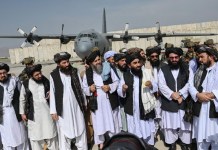Two Russian Tu-160 strategic bombers flew over the Baltic region only to be intercepted by NATO fighters — Italian Air Force F-35As, Royal Danish Air Force F-16s, and Swedish Air Force JAS 39 Gripens.
This comes days after a Russian Sukhoi Su 30-SM fighter jet had its first encounter with an Italian F-35A Lightning II aircraft.
According to The Aviationist, two Blackjacks were escorted by two Su-27 fighters of the Baltic Fleet’s naval aviation and two Su-35 aircraft of the Aerospace Force, in an eight-hour long-range aviation (LRA) mission in the Baltic region.
“The crews of Russian long-range aircraft regularly perform flights over the neutral waters of the Arctic, the North Atlantic, the Black and Baltic Seas, and the Pacific Ocean”, Russia’s Defence Ministry said.
On June 11, a Russian Sukhoi Su 30-SM fighter jet had its first encounter with an Italian F-35A Lightning II aircraft. In a video posted on social media, the F-35A fighter jet was seen approaching a Russian An-12 transport aircraft which was escorted by a Su 30-SM fighter jet to Kaliningrad Oblast, off Estonia, The Eurasian Times reported.
The eight-hour operation forced NATO fighters to conduct Quick Reaction Alert (QRA) as a part of the NATO Baltic Air Policing Mission. However, no official photographs or videos were released, as of now, by NATO and the Italian Air Force.
Tu-160 bombers are believed to be the largest and heaviest combat aircraft in service. They are owned by the 121st Guards Heavy Bomber Aviation Regiment, which is stationed at Engels Air Force Base in Saratov.
The TU-160 is nicknamed White Swan because the white reflective coating on the bomber is meant to protect the crew.
The Tu-160 was developed as a response to America’s B-1 Lancer, which is also a supersonic variable-sweep wing, heavy bomber, drawing similarities between the two. It was inducted into service in April 1987.
The bomber is capable of carrying conventional and nuclear weapons including long-range nuclear missiles. It can deliver the strategic cruise missile, Kh-55MS (with a maximum range of 3,000 kilometres), and Kh-15P with a range of up to 200 kilometers. It has an all-weather, day-night capability and can operate at all geographical latitudes.
Today two @BeAirForce #F16 of #NATO's #BAP mission intercepted two Russian #TU160 Blackjack and two Russian #SU27 Flanker above the Baltic Sea. It was the first scramble for the Belgian detachment which is safeguarding the Baltic airspace since the 3th of september. #WeareNATO pic.twitter.com/WK91ZvVTzU
— Belgian Air Force?? (@BeAirForce) September 17, 2019
The aircraft is highly computerized and the avionics systems include an integrated aiming, navigation, and flight control system, with navigation and attack radar, an electronic countermeasures system, and automatic controls.
The bomber uses fly-by-wire controls. The aircraft is equipped with three-strut landing gear, a tail-wheel, and a brake parachute. For take-off, the aircraft requires a 3.5 km runway of solid concrete. The crew of the Tu-160 comprises a pilot, co-pilot, a navigator, and an operator.
Written by Kanika Sachdeva




